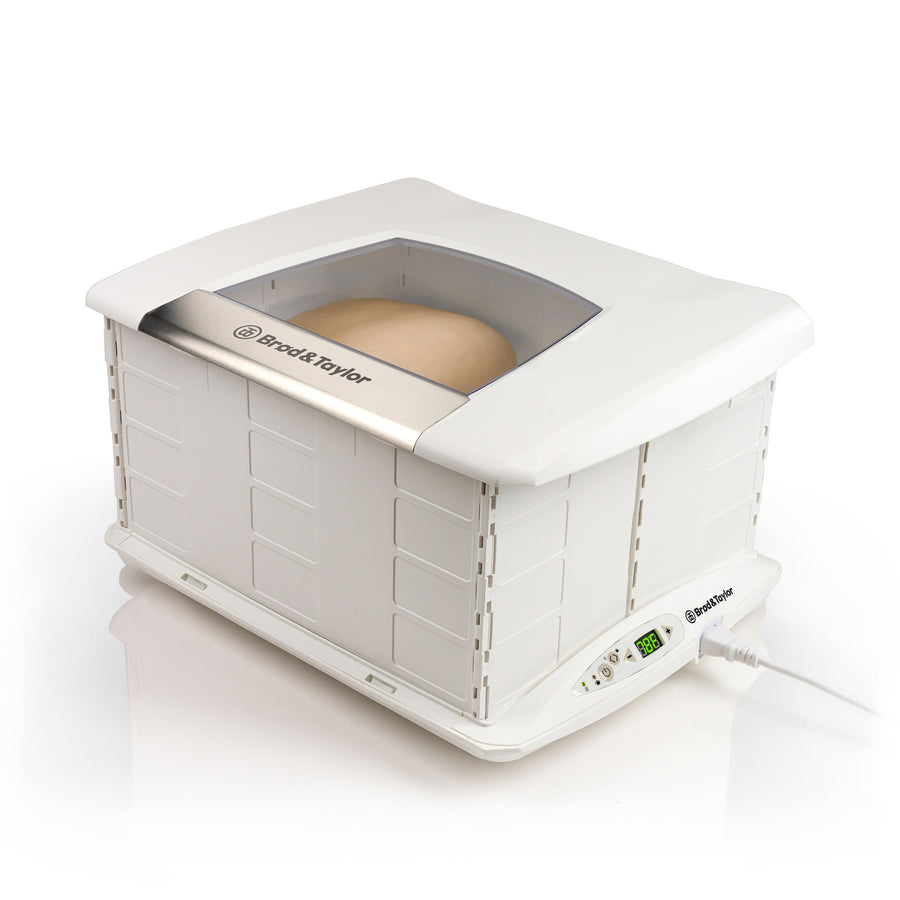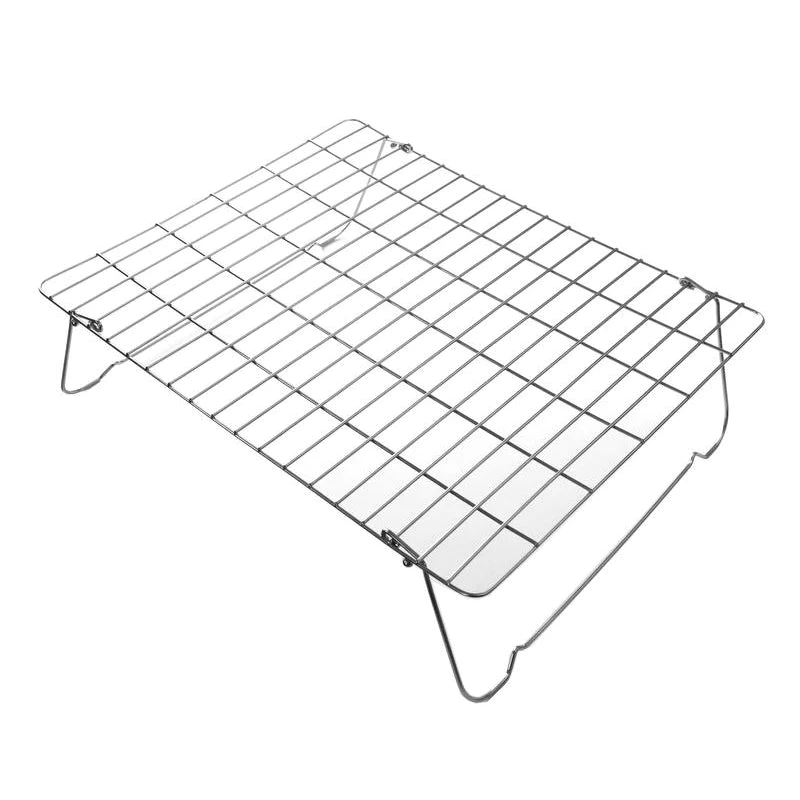The Brod and Taylor Folding Fermentation Box and Slow Cooker is a versatile kitchen appliance. It provides an ideal temperature and humidity environment for bread fermentation and can also be used for slow cooking various ingredients. When folded, this device occupies only 1/3 of its original size, making storage convenient.
Product Features:- Folding design saves storage space
- Precise temperature control, ranging from 21°C to 90°C
- Built-in humidity control system
- Can be used for bread fermentation, slow cooking, yogurt making, and other purposes
- Large capacity, can accommodate two 900-gram bread molds
- Quiet operation
- Energy-efficient design
| Specification | Details |
|---|---|
| Temperature Range | 21-90°C |
| Typical Humidity | 60-80% |
| Main Body Material | Reinforced Polypropylene |
| Water Tray Material | Aluminum |
| Heating Plate Material | Solid Brushed Aluminum |
| Internal Dimensions | 37.5 x 32 x 20 cm (Height without rack: 21.6 cm) |
| External Dimensions (Expanded) | 46 x 37 x 25.5 cm |
| External Dimensions (Folded) | 46 x 37 x 6.5 cm |
| Weight | 4.3 kg |
| Power Supply | 220-240V, 50Hz (180-220W) |
| Accessory Storage | Rack and water tray can be stored inside the folded fermentation box |
| Model Number | International Version (220-240V): FP-205 |
The fermentation box can accommodate two "large" bread molds, each approximately 900 grams. Using the Brød & Taylor rack accessory can double the capacity. The internal space of the fermentation box is 37.5 x 32 x 20 cm. If the overall dimensions of the mold (including edges and/or handles) are less than 30.5 x 35.5 cm, it can be placed inside. For optimal temperature and humidity circulation, place the molds in the center of the fermentation box.
Home bakers often lack a well-controlled fermentation environment, putting them at a disadvantage. Most bakers understand that high-quality bread requires premium ingredients. However, even with the best ingredients, homemade bread often lacks flavor and texture, appearing flat in all aspects. This is because bakers miss out on the essential "ingredient" they need most: time at the proper temperature. The key step that differentiates high-quality bread from ordinary bread is allowing the dough to ferment slowly at an ideal temperature. A fermentation box allows you to create the best texture and taste of homemade bread in a repeatable and consistent manner.
The Folding Fermentation Box is not a bread machine. It is an environment for fermenting and proofing yeast dough. It eliminates the variable temperature and humidity issues that trouble all bakers, whether beginners or professionals baking bread at home. With the Folding Fermentation Box, you no longer have to worry about finding a "warm, draft-free place" in your home to ferment dough. The fermentation box allows you to bake high-quality bread at home in a predictable manner. Compared to bread made by a bread machine, you'll find that handmade bread has better texture and taste. You still need to mix the dough yourself, and for some breads, you need to knead by hand or with a mixer. You can use your own molds or shape traditional free-form bread. Fermenting in a temperature-controlled environment and then baking in a preheated oven can produce higher quality, more delicious bread.
Yes, the fermentation box has been tested and approved for unattended operation and can run continuously. It has low power consumption, consuming about 0.03 kilowatt-hours per hour when set to 24°C.
The temperature range suitable for bread dough is broad. If your recipe or book specifies a temperature, consider using that setting. - Sourdough ferments best at 27-30°C, promoting wild yeast activity. - Commercial yeast is more active, so doughs made with it benefit from lower temperatures, 24-26°C, which favor flavor development. - Sweet doughs and croissants typically contain butter and work best when temperatures are kept below the melting point of butter. We recommend these doughs use a temperature of 27°C or lower. - Rye flour has weaker gluten and higher enzyme activity. Higher fermentation box temperatures (27-30°C) are suitable to shorten fermentation time and prevent enzymes from breaking down the dough too quickly. - Dough refrigerated in the fridge usually needs an additional hour (or more per 500 grams of dough) of fermentation time to allow the dough to reach room temperature. Ideally, frozen dough should be thawed in the fridge before fermentation.
The fermentation box is calibrated to maintain the contents of the container at the specified temperature setting, not the internal air temperature. Measuring the air temperature inside the fermentation box with a thermometer does not reflect the temperature of the food inside the container. This is because the fermentation box primarily heats the food container directly through the aluminum heating plate at the base. The air temperature inside the fermentation box will warm up but will not be the same as the temperature of the food inside the container. In fermentation mode, items should always be placed on the rack. Two important factors affect the temperature of the food in the fermentation box: - Covering the container increases the temperature of the food inside the container - Adding water to the tray to create humidity increases the temperature of the food in the container. The fermentation box can be calibrated in two ways: - Wet (with water tray): 21-35°C. Use open containers. Place bread dough and pre-ferments in open bowls, bread molds, or baking pans. - Dry (without water tray): 21-49°C. Use closed containers. Typically used for culturing yogurt. If using the fermentation box in dry mode at 21-35°C, the food temperature may be a few degrees lower than the setting.
Most doughs and shaped breads do not need to be covered in the fermentation box because the water tray provides ideal humidity to prevent the surface of the dough from forming a skin. All bread recipes on the Brod & Taylor website are developed with temperature settings for uncovered dough. If you cover the dough, you may find the dough temperature increases by 2-5 degrees, depending on how long the dough is in the fermentation box. However, if you are using the fermentation box for long fermentation, such as overnight pre-fermentation at low temperatures, it may be safest to cover the bowl or container.
Fermentation is the process of developing flavor, and it takes longer than proofing. When yeast (either commercial or wild) is introduced to flour and water, fermentation begins. Pre-fermentation is a controlled aging process that allows the yeast to freely consume, as initially there are few yeast cells. Proofing is the final gas-producing stage that inflates the dough, preventing it from becoming dense and gummy. Proofing is still part of fermentation and is sometimes referred to as the final fermentation. A single bread dough undergoes bulk fermentation after mixing and kneading. After shaping, it undergoes proofing or "final fermentation."
If your fermentation box is set to a lower temperature of 24°C, it may not feel very warm even if it is working properly. To speed up fermentation, you can set the temperature to 29-32°C. If you have been fermenting bread in the oven or another warmer place, you might need to set the fermentation box temperature higher to achieve similar results. However, the best flavors in bread are usually obtained when you allow the dough sufficient time to ferment slowly.
To achieve optimal heat circulation and the most accurate culture temperature, avoid placing jars or containers directly in the center of the fermentation box. The fermentation box can hold eight 1-liter mason jars without needing to place a jar in the center. For cultures or fermentations that require long durations (more than 12 hours), slow cook mode may provide more stable results, which can be set as low as 30°C. Food jars or other containers can be placed inside a larger shallow container (such as a soup pot or aluminum baking tray), covered with a lid or aluminum foil, and placed directly on the heating plate. Use the mode button to select slow cook and set the desired temperature.
1. Low-temperature ovens cannot control and maintain temperature accurately degree by degree. 2. Low-temperature ovens do not have proper humidity control. The lowest temperature of a low-temperature oven cannot maintain very low temperature ranges starting from 21°C. 3. Our fermentation box is engineered and calibrated to maintain the internal temperature of bread dough, yogurt cultures, or any food being made inside. Low-temperature ovens are set for the air temperature inside the oven, not for the temperature of the ingredients being prepared. Recipes developed by Brod & Taylor have been successfully tested at the specific temperature settings specified for each recipe.
Yes, the fermentation box has a thermostat on the base. The heating element cycles on and off based on the temperature of the aluminum plate. This cycling occurs within a narrow range, making the fermentation box very precise and reliable in maintaining a stable temperature.
The fermentation box has been calibrated for room temperatures between 18-21°C. The fermentation box is designed only to heat its contents and cannot cool. If the room temperature is higher than the set point, the fermentation box cannot become cooler. If the ambient temperature is very low - below 13°C, you may need to set the temperature a few degrees higher to achieve the desired effect.
1. Ensure the folding side is properly tucked and connected to the hinge at the back of the base of the fermentation box. 2. Ensure the small plastic cross guide rails are visible on the top. 3. Place the wire rack feet facing up so they are secured by the cross guide rails.
Typically, preheating for 10-15 minutes is sufficient.
Place the French baguettes on baking cloth on a flat baking tray or other non-absorbent flat support. We cut full-size baking cloths in half so there isn't too much fabric blocking the moisture. Using the rack accessory allows for two layers of French baguettes, so we like to have two pieces of baking cloth for the fermentation box. Lightly dust the baking cloth with flour and never wash it. After each use, shake it out and lightly re-dust with flour before each use. Place the baking cloth on a small flat baking tray to facilitate moving in and out of the fermentation box. A flat baking tray is best so you can gently roll each French baguette onto a baking peel. We always preheat the fermentation box about 30 minutes before fermentation and ensure there is water in the tray at the bottom.
Sticky dough is usually caused by overhydration or over-fermentation. Yeast microorganisms cannot move on their own to seek out new food, so punching down or degassing can help them do so. Under normal conditions, yeast has enough food after at least one punch down and a second fermentation to ferment again. Ultimately, the yeast will consume too much food, causing the dough to break down and become very sticky. Once this happens, the dough is ruined.
To prevent the folding side from coming off, we recommend always connecting it to the hinge at the back of the base of the fermentation box during the folding and setting up process.
No, the folding fermentation box operates silently.
When the fermentation box is set up, the lid rests on the side walls. It does not click or lock into place. However, there is a specific method to align the lid for proper installation. The two square protrusions on the back of the lid fit into the square grooves on the back wall, and then the lid is hinged down to the side walls.
The fermentation box consumes 200 watts. When running, it operates on a cycle of approximately 30%. This means the heater is only on 30% of the time at 200 watts, depending on the temperature setting (the lower the temperature, the less the heater runs). If the fermentation box were on 100% of the time, it would use: - 200 watts x 1 hour = 200 watt-hours (0.2 kilowatt-hours) But since it is only on about 30% of the time, the actual energy consumption is: - 200 watt-hours x 0.3 = 60 watt-hours = 0.06 kilowatt-hours per hour In other words, it uses the same energy as a 60-watt bulb.
Slow cook mode directly controls your pot temperature through the aluminum plate. This is different from fermentation mode, which calibrates the plate's temperature to maintain your dough, yogurt, or other food at a specific set temperature. Comparing the temperature settings of the Folding Fermentation Box and Slow Cooker to traditional slow cookers requires some explanation. Most traditional slow cookers (usually with only low and high settings) actually have no temperature control. They heat slowly and continuously until reaching the maximum temperature—usually the boiling point. This means that most of the slow cooker's time, your food is either below or above the ideal cooking temperature. In many slow cookers, the low and high settings are actually the same. Some "multi-function pots" with slow cook features do have temperature control, but performance varies widely between brands, and the low or high settings have no universal standard. Our Folding Slow Cooker uses calibrated temperature control to maintain the selected temperature. You can choose the ideal cooking temperature for your recipe without worrying about overcooking your food. When using a flat-bottomed stainless steel pot, the temperature settings are the most accurate, but most types of metal pots can be used.
Using a stainless steel pot with a thick flat bottom can achieve the most accurate temperature settings. The best choice is a pot with some sort of heat-conducting metal (like aluminum) at the bottom. All Clad™ soup pots are one of our favorites, but there are many other brands available. You can use cast iron Dutch ovens, whether bare cast iron or enameled, but at the highest temperature settings, these pots may be 5-8°C below the set temperature. To achieve the highest temperature in a cast iron Dutch oven, you can wrap it in a layer of aluminum foil to significantly reduce heat loss. If wrapped in aluminum foil, enameled cast iron Dutch ovens can reach the same high temperatures as stainless steel pots.
Slow cooking should always be done in metal pots. Ceramic pots and baking bowls have poor heat conduction and cannot reach the set temperatures.
Ensure you have removed the rack from the fermentation box. The pot must be placed directly on the aluminum heating base. The temperature of the food in the pot may vary slightly depending on the type of pot. When using a stainless steel pot with a thick bottom, the temperature settings are the most accurate.
The Folding Fermentation Box and Slow Cooker have no specific limits on operating time. Most slow cook recipes require up to 10-12 hours. Slow-roasted black garlic may take up to four weeks at 60°C. The original model FP-101 Folding Fermentation Box can also run continuously for weeks or months.
If the device gets dirty, do not submerge the base in water. Instead, use a soft cloth dampened with a little water to remove spills. As a precaution, before using the fermentation box, you can place a piece of aluminum foil under the pot on the base so that any spills are easily collected and discarded.








































